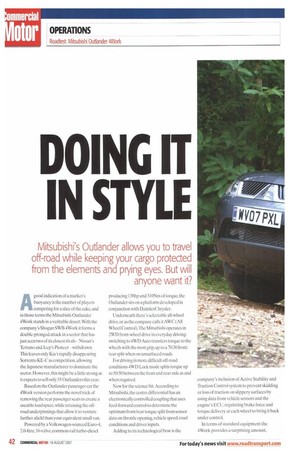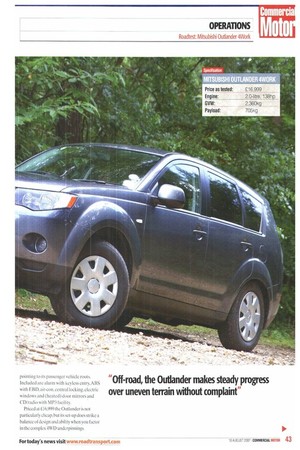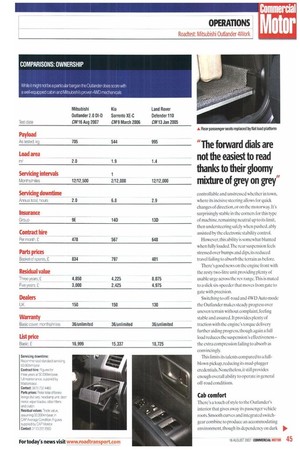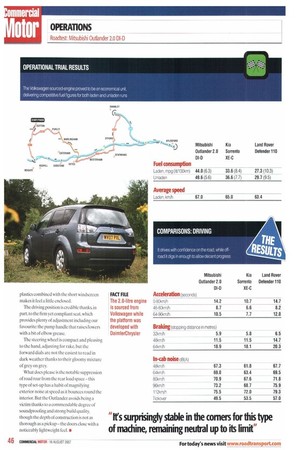DOING IT IN STYLE
Page 42

Page 43

Page 44

Page 45

Page 46

If you've noticed an error in this article please click here to report it so we can fix it.
Vitsubishi's Outlander allows you to travel off-road while keeping your cargo protected from the elements and prying eyes. But will anyone want it?
Agood indication of a market's buoyancy is the number of players competing for a slice of the cake, and in those terms the Mitsubishi Outlander 4Work stands in a veritable desert. With the company's Shogun SWB 4Work it forms a double-pronged attack in a sector that has just seen two of its closest rivals — Nissan's Terrano and Jeep's Pioneer —withdrawn. This leaves only Kia's rapidly disappearing Sorrento KE-C as competition, allowing the Japanese manufacturer to dominate the sector. However, this might be a little strong as it expects to sell only 55 Outlanders this year.
Based on the Outlander passenger car the 4Work version performs the novel trick of removing the rear passenger seats to create a useable load space, while retaining the offroad underpinnings that allow it to venture further afield than your equivalent small van.
Powered by a Volkswagen-sourced Euro-4, 2.0-litre,16-valve, common-rail turbo-diesel producing l3Shp and 310Nm of torque, the Outlander sits on a platform developed in conjunction with DaimlerChrysler.
Underneath there's selectable all-wheel drive. or as the company calls it AWC (All Wheel Control).The Mitsubishi operates in 2WD front-wheel drive in everyday driving: switching to 4WD Auto transfers torque to the wheels with the most grip, up to a 70:30 front: rear split when on unsurfaced roads.
For driving in more difficult off-road conditions 4WD Lock mode splits torque up to 50:50 between the front and rear axle as and when required.
Now for the science bit.According to Mitsubishi, the centre differential has an electronically controlled coupling that uses feed-forward control to determine the optimum front/rear torque split from sensor data on throttle opening, vehicle speed, road conditions and driver inputs.
Adding to its technological bow is the company's inclusion of Active Stability and Traction Control system to prevent skidding or loss of traction on slippery surfaces by using data from vehicle sensors and the engine's ECU, regulating brake force and torque delivery at each wheel to bring it back under control.
In terms of standard equipment the 4Work provides a surprising amount, pointing to its passenger vehicle roots. Included are alarm with keyless entry,ABS with EBD, air-con. central locking, electric windows and (heated) door mirrors and CD/radio with M P3 facility.
Priced at il6,999 the Outlander is not particularly cheap, hut its set-up does strike a balance of design and ability when you factor in the complex 4WD underpinnings.
Productivity
With a full payload we expected the Outlander to struggle a little due to its original role, so 44.0 mpg was a decent result considering, and this was raised to 49.6mpg on an unladen run.
With 2m3 of loadspace to play with you shouldn't be expecting to pack more than supplementary tools and kit in the rear, but it's surprisingly well designed considering the exterior's designer curves.
The flat carpeted surface is complemented by the near-vertical side walls and minimal wheelarch intrusion, allowing maximum use of the space available.
To avoid cargo venturing forward into the cabin a token metal lip is provided at the front of the load area, though this won't be enough if you have to stack your load.
Getting the goods in is assisted by a high degree of practical access. At the rear of the Outlander a split tailgate allows you to open just the larger top hatch if required, while the lower lip drops down at the pull of a lever to provide a useful platform to rest tools/goods/ rear on.
The rear passenger doors also open out to allow easy access to the front of the load area.
On the road
Removing the rear seats on a passenger vehicle is not going to greatly change the way it drives, but adding three quarters of a tonne in payload is a different matter.With a marginal load the Mitsubishi performs well, remaining controllable and unstressed whether in town, where its incisive steering allows for quick changes of direction, or on the motorway. It's surprisingly stable in the corners for this type of machine, remaining neutral up to its limit, then understeering safely when pushed, ably assisted by the electronic stability control.
However, this ability is somewhat blunted when fully loaded:The rear suspension feels stressed over bumps and dips, its reduced travel failing to absorb the terrain as before.
There's good news on the engine front with the zesty two-litre unit providing plenty of usable urge across the rev range.This is mated to a slick six-speeder that moves from gate to gate with precision.
Switching to off-road and 4WD Auto mode the Outlander makes steady progress over uneven terrain without complaint, feeling stable and assured. It provides plenty of traction with the engine's torque delivery further aiding progress, though again a full load reduces the suspension's effectiveness— the extra compression failing to absorb as convincingly.
This limits its talents compared to a fullblown pickup, reducing its mud-plugger credentials. Nonetheless, it still provides enough overall ability to operate in general off-road conditions.
Cab comfort
There's a touch of style to the Outlander's interior that gives away its passenger vehicle roots. Smooth curves and integrated switchgear combine to produce an accommodating environment, though its dependency on dark plastics combined with the short windscreen makes it feel a little enclosed.
The driving position is credible thanks, in part, to the firm yet compliant seat, which provides plenty of adjustment including our favourite: the pump handle that raises/lowers with a bit of elbow grease.
The steering wheel is compact and pleasing to the hand, adjusting for rake, but the forward dials are not the easiest to read in dark weather thanks to their gloomy mixture of grey on grey.
What does please is the notable suppression of road roar from the rear load spacethis type of set-up has a habit of magnifying exterior noise at speed as it bounces round the interior. But the Outlander avoids being a victim thanks to a commendable degree of soundproofing and strong build quality, though the depth of construction is not as thorough as a pickupthe doors close with a noticeably lightweight feel. •
























































































































































































